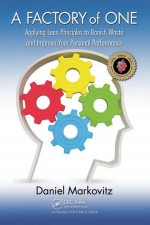Tab Article
Most business readers have heard of the Lean principles developed for factories - a set of tools and ideas that have enabled companies to dramatically boost quality by reducing waste and errors - producing more while using less. Yet until now, few have recognized how relevant these powerful ideas are to individuals and their daily work. Every person at a desk, drafting table, workstation, or operating table must (like a factory) deal with the challenge of reducing the waste that creeps into their work. The same Lean principles that have improved efficiencies on the factory floor can be just as powerful - in fact, far more so - in helping individuals boost personal performance.
A Factory of One: Applying Lean Principles to Banish Waste and Improve Your Personal Performance describes how you can foster a new mindset and improve your performance by applying Lean methods to your work. It translates powerful Lean tools such as visual management, flow, pull, 5S, and kaizen to your daily work, revealing how they can help to improve efficiency, reduce waste, and link you ever more closely to customer value. This practice will help you develop better self-awareness, more disciplined problem-solving skills, and the ability to self-correct errors.
This book not only provides the tools, but also teaches you how to find the root causes underlying your inefficiencies so you can eliminate them permanently. It will enable you to immediately improve personal productivity while developing the skills needed for continuous improvement. It includes real-world examples that illustrate how these principles have been successfully applied across a range of industries. Providing the perfect mix of what-to-do with why-to-do it, the text details a step-by-step approach to applying Lean principles to your work.


